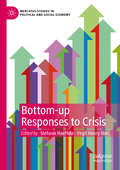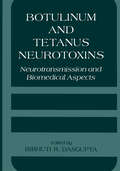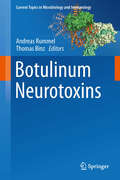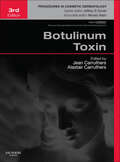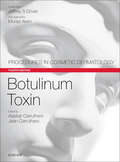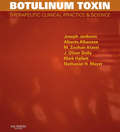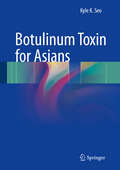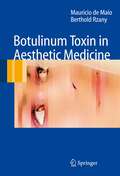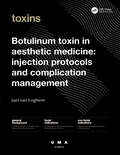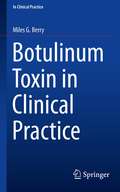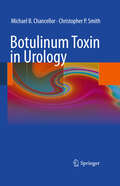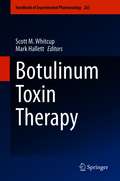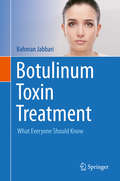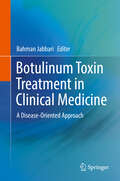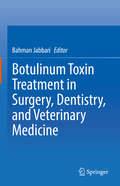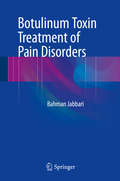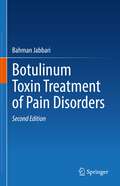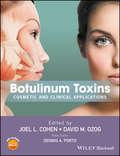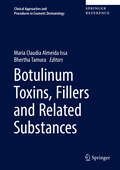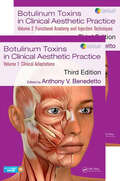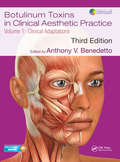- Table View
- List View
Bottom-up Responses to Crisis (Mercatus Studies in Political and Social Economy)
by Stefanie Haeffele Virgil Henry StorrCrises occur in all societies across world, and can be natural (such as hurricanes, flooding, and earthquakes), man-made (such as wars and economic downturns), or, often, a combination of both (such as famines, the flooding of New Orleans in 2005 after Hurricane Katrina and subsequent levy failures, and the earthquake, tsunami, and nuclear disaster in Japan in 2011). Crises cause fatalities, injuries, and property damages as well as introduce uncertainty and challenges for individuals, societies, and polities. Yet, we see individuals and communities rebounding effectively from crises all the time. How do communities go about returning to normalcy and beginning again the mundane life of every day affairs? This edited volume looks at bottom-up responses to crises. The chapters in this volume will highlight the ingenuity and persistence of individuals and private organizations as well as discuss the possibilities, limitations, and adaptability of bottom-up responses. It argues that there are many ways that local leaders, entrepreneurs, and community members can play a role in their own recovery by examining the capabilities, feedback mechanisms, and network effects of decentralized crisis response and recovery efforts. Chapters will focus on the role of local emergency managers in the disaster management process and offer suggestions for reform and the role of businesses, citizens, and children in providing crisis response and recovery. This book will also consider theories of self-governance and nonviolent action in encouraging and sustaining bottom-up recovery.
Botulinum and Tetanus Neurotoxins: Neurotransmission and Biomedical Aspects
by B. R. DasGuptaThree days in Madison have thoroughly modified my view on clostridial neurotoxins. While still realizing the numerous activating, modifying and protective inputs, I cannot judge the meaningfulness of the meeting impartially. Neither may the reader expect a complete summary of all presentations. Collected in this volume, they speak for themselves without requiring an arbiter. Instead I shall write down my very personal opinions as a researcher who has studied clostridial neurotoxins for nearly 25 years. Comparable conferences have been rare during this time. A comprehensive symposium 4 on C. botulinum neurotoxins has been organized at Ft. Detrick. International conferences on tetanus have been held regularly under the auspices of the Wodd Health Organization. One or maximally two days of these meetings have been devoted to tetanus toxin and its actions whereas the sponsor and the majority of the participants have been interested mainly in epidemiology, prevention and treatment of tetanus as a disease (see refs. 5,6). Some aspects of clostridial neurotoxins have been addressed in the context of bacterial toxins, in particular in the biennial European workshops. 1-3,7,8 The Madison meeting differed from the previous ones in three aspects. First, it covered both tetanus and botulinum neurotoxins. The fusion was justified because of their huge similarities in primary structure, in their mode of action and in their cellular targets. Second, the meeting was not limited to toxins but drew some lines on which modern neurobiology might proceed.
Botulinum Neurotoxins (Current Topics in Microbiology and Immunology #364)
by Andreas Rummel and Thomas BinzThe extremely potent substance botulinum neurotoxin (BoNT) has attracted much interest in diverse fields. Originally identified as cause for the rare but deadly disease botulism, military and terrorist intended to misuse this sophisticated molecule as biological weapon. This caused its classification as select agent category A by the Centers for Diseases Control and Prevention and the listing in the Biological and Toxin Weapons Convention. Later, the civilian use of BoNT as long acting peripheral muscle relaxant has turned this molecule into an indispensable pharmaceutical world wide with annual revenues >$1.5 billion. Also basic scientists value the botulinum neurotoxin as molecular tool for dissecting mechanisms of exocytosis. This book will cover the most recent molecular details of botulinum neurotoxin, its mechanism of action as well as its detection and application.
Botulinum Toxin E-Book: Procedures in Cosmetic Dermatology Series (Procedures in Cosmetic Dermatology)
by Alastair Carruthers Jean CarruthersThis title in the PROCEDURES IN COSMETIC DERMATOLOGY SERIES presents up-to-the-minute, practical guidance on botulinum toxin injection techniques shaping today's practice. Succinctly written and lavishly illustrated, it focuses on procedural how-to's and offers step-by-step advice on proper techniques, pitfalls, and tricks of the trade—so you can refine and hone your skills...and expand your surgical repertoire. You'll find current, to-the-point guidance on the cosmetic use of the toxin — edited by pioneers in the field, Drs. Jean and Alastair Carruthers. Implement the newest procedures into your practice immediately and confidently—with the outstanding guidance you'll find in this volume of the PROCEDURES IN COSMETIC DERMATOLOGY SERIES.Covers the hottest topics—including botox aesthetics, facial treatments, neck treatment, adjunctive treatment, pain relief, and facial asymmetry—all in one concise, accessible volume. Features a wealth of color illustrations and photographs that depict cases as they present in practice.Discusses common pitfalls and emphasizes how to optimize outcomes, enabling readers to improve their technique.Highlights emerging topics in the field, with guidance on the newest developments in cosmetic surgery.Includes a comprehensive, instructional DVD containing video clips of techniques and procedures as well as the experts' hints and tips.Use of fillers in combination with Botox to better sculpt the lower faceCoverage of new fillers like Juvederm, Evolence, Radiesse and Perlane to keep you on the cutting edgeNew and expanded coverage of periocular treatmentHighest quality video footage of procedures on the bonus DVD
Botulinum Toxin E-Book: Procedures in Cosmetic Dermatology Series (Procedures in Cosmetic Dermatology)
by Alastair Carruthers Jean CarruthersPart of the practical and dynamic Procedures in Cosmetic Dermatology Series, Botulinum Toxin, 4th Edition, brings physicians at all levels of experience up to speed with today’s best injection techniques. This well-organized text provides current, authoritative guidance on popular procedures including masseter hypertrophy and darker skin types, the therapeutic uses of botulinum toxins, and their future in dermatology. The renowned author team of Drs. Jean Carruthers and Alastair Carruthers offers evidence-based, procedural how-to's and step-by-step advice on proper techniques, pitfalls, and tricks of the trade, so you can successfully incorporate the latest procedures into your practice. Includes complete, clear descriptions and rationales for injection placement for facial and neck rejuvenation and hyperhidrosis, with high-quality videos demonstrating the techniques of injection. Addresses the differences in doses and particular characteristics among different botulinum toxin preparations in every chapter. Features a well-organized format with key points lists, pearls, and case studies as they appear in practice. Contains new chapters throughout, plus new information on injectable daxibotulinumtoxinA (RT002), topical botulinum toxin type A and benzyl alcohol. Includes many new images that depict exactly how to perform the techniques.
Botulinum Toxin E-Book: Therapeutic Clinical Practice and Science
by Joseph Jankovic Alberto Albanese M. Zouhair Atassi J. Oliver Dolly Mark Hallett Nathaniel H. MayerThe new, therapeutically-focused Botulinum Toxin presents comprehensive, cross-disciplinary guidance on current practices, covering more than 100 non-cosmetic conditions that occur in neurology, physical medicine and rehabilitation, pain medicine, ophthalmology, gastroenterology, urology, orthopedics, and surgery. International contributors review the current understanding of the biology and cellular mechanisms along with relevant research so you can easily apply them to the pathophysiology of the numerous disorders that botulinum toxin is used to treat—such as botulinum toxin applications for the treatment of cranial-cervical dystonias, motor disorders in cerebral palsy, bruxism and temporomandibular disorders, headache, overactive bladder, chronic pelvic pain syndromes, arthritis joint pain, and wound healing. With discussions of the latest in approved treatment practices as well as new and emerging uses, you’ll get in-depth management guidance on the application of the toxin.Provides clinical applications of botulinum toxin for over 100 disorders for immediate access and easy reference during practice and treatment. Covers a broad array of hot topics, including botulinum toxin applications for the treatment of cranial-cervical dystonias, motor disorders in cerebral palsy, bruxism and temporomandibular disorders, headache, overactive bladder, chronic pelvic pain syndromes, arthritis joint pain, and wound healing. Focuses on approved uses with expert advice on thoroughly tested applications but also discusses new and emerging applications to expose you to additional treatment options. Presents the most comprehensive and up-to-date material available so you get all the information you need from this one resource. Offers the cross-disciplinary guidance of the best world-class expertise through an authoritative, international group of authors who demonstrate the applications of botulinum toxin across various specialties.
Botulinum Toxin for Asians
by Kyle K SeoThis book, containing more than 400 photos and illustrations, provides practical guidelines for the cosmetic use of botulinum toxin type A (BTA) in Asians. The differences in BTA treatment of Asians and Caucasians with respect to applicable dose, injection methods, anatomic significance, and indications are clearly described. It is explained how the optimal dose and injection sites for the treatment of wrinkles differ from the guidelines advocated in North America and Europe. Detailed consideration is given to the rapidly expanding role that BTA treatment is playing in facial and body contouring based on leveraging the mechanism of disuse muscle atrophy. Examples that are particularly relevant in Asians include treatment of hypertrophy of the masseter and temporalis muscles and calf muscle reduction. Further chapters are devoted to the use of BTA in the treatment of hyperhidrosis and the intradermal injection of BTA. The book will be an excellent resource for all dermatologists, plastic surgeons, cosmetic Physicians, and other clinicians who employ BTA in Asian patients.
Botulinum Toxin in Aesthetic Medicine
by Mauricio de Maio Berthold RzanyWritten by two renowned experts, this book surveys the use of botulinum toxin A in aesthetic medicine, including patient selection and evaluation, as well as rules and requirements. The book provides hands-on information for common indications, such as forehead and glabella, lateral brow lift, crow’s feet and lower eyelid, bunny lines and marionette lines, nose and nasolabial folds, cheeks and "gummy smile," upper and lower lip, and the chin and neck. A section with tips and tricks makes this book an invaluable resource for the practicing dermatologist, plastic surgeons and all other physicians interested in the field of aesthetic medicine.
Botulinum Toxin in Aesthetic Medicine: Injection Protocols and Complication Management (UMA Academy Series in Aesthetic Medicine)
by Jani van LoghemBotulinum Toxin in Aesthetic Medicine: Injection Protocols and Complication Management This practical book is a quick review of the necessary details for safe and effective deployment of botulinum toxins in day-to-day practice, covering basic background information about the products, patient consultation, and treatment preparation, with more emphasis on injection patterns, relevant anatomy, and avoiding and treating complications. Offers a succinct but practical synopsis of treatment Presents a user's guide to the world's most popular aesthetic treatment Showcases the experience and viewpoint of a busy, dedicated aesthetic practice
Botulinum Toxin in Aesthetic Medicine: Injection Protocols and Complication Management (UMA Academy Series in Aesthetic Medicine)
by Jani van LoghemBotulinum Toxin in Aesthetic Medicine: Injection Protocols and Complication Management This practical book is a quick review of the necessary details for safe and effective deployment of botulinum toxins in day-to-day practice, covering basic background information about the products, patient consultation, and treatment preparation, with more emphasis on injection patterns, relevant anatomy, and avoiding and treating complications. Offers a succinct but practical synopsis of treatment Presents a user's guide to the world's most popular aesthetic treatment Showcases the experience and viewpoint of a busy, dedicated aesthetic practice
Botulinum Toxin in Clinical Practice (In Clinical Practice)
by Miles G. BerryThis book concisely summarizes the use of Botulinum neurotoxin in facial rejuvenation. It details relevant aspects of the physiology, pharmacology, safety profile and anatomy of the toxin. Chapters breakdown critical aspects related to the clinical assessment and aesthetic administration of this neurotoxin along with insightful information on its regulation. Botulinum Toxin in Clinical Practice provides a practically focused introductory text to the cosmetic applications of this neurotoxin in aesthetic dermatology, making it an ideal resource for the trainee practitioner seeking a concise summary of the topic.
Botulinum Toxin in Facial Rejuvenation E-Book: Botulinum Toxin in Facial Rejuvenation E-Book
by Kate ColemanNow thoroughly revised to reflect state-of-the-art advances in the field, Botulinum Toxin in Facial Rejuvenation, 2nd Edition, covers the entire range of the use of botulinum toxin for cosmetic purposes. Dr. Kate Coleman offers practical guidance for safe handling, selection and assessment of patients, potential complications and pitfalls, and aesthetic techniques, as well as comparative modalities and long-term management. This is an ideal resource for anyone who offers this sought-after procedure, including cosmetic surgeons, oculoplastic surgeons, dermatologists, physician's assistants, and registered nurses. - Features new, unique coverage of long-term management, picturing the same original patients 15 years later, as well as observations on how treatments should be adjusted as the patient gets older in order to respond to natural changes in bone density and underlying support structures. - Presents new knowledge on neuromodulation and how treatment can be used to 'retrain' expressions to provide fewer frowns lines and better facial symmetry. - Offers comparative information on other modalities such as laser and hyaluronic acid, as well as potential risk factors, so you can choose the best procedure for each patient. - Discusses the various forms of botulinum toxin currently available on the market, with an emphasis on Botox, Xeomin, and Dysport. - Uses full-color clinical photos of pre-, peri-, and post-operative results to illustrate nuances of techniques as well as the effectiveness of botulinum toxin on wrinkles and scars for the major facial areas. - Provides current guidelines on treatment methods and best practices for reconstitution and storage. - Discusses which patients may be at risk for adverse effects?or "worsening results"?and offers suitable alternatives.
Botulinum Toxin in Urology
by Michael B. Chancellor Christopher P. SmithBladder injection of onabotulinumtoxinA for the treatment of urinary incontinence due to neurogenic detrusor overactivity has recently been approved by regulatory agencies in several EU countries and by the FDA in the United States. This is the first book to focus on the practical application of botulinum toxin (BoNT) in the genitourinary tract. It covers in detail applications of BoNT in the bladder and the prostate and pelvic floor, with reviews of the latest clinical series and techniques in both adults and children. Appendices containing easy-to-read instructions for patients undergoing bladder and prostate BoNT injections are included, in addition to procedural guidelines for nursing staff. The book is written in a concise, clinically relevant style by two leading pioneers in the field, who were the first to undertake comprehensive basic research into the mechanisms underlying the efficacy and potential uses of BoNT within the lower urinary tract.
Botulinum Toxin Therapy (Handbook of Experimental Pharmacology #263)
by Scott M. Whitcup Mark HallettIn a rapidly progressing field, Botulinum Toxin Therapy provides both clinicians and basic researchers with the latest science on the structure and function of botulinum toxins and the use of these toxins to treat a wide variety of diseases. Part 1 of the book reviews the basic science of botulinum toxins including advances in our understanding of the molecular structure and mechanism of action of botulinum toxins. This section also discusses the manufacturing and formulation of botulinum toxins for clinical use and the development of novel therapeutic toxins for the future. Part 2 reviews the use of botulinum toxins in clinical practice. It discusses the clinical pharmacology of botulinum toxin drugs and their use in a wide variety of clinical conditions including headache, spasticity, pain, disorders of the genitourinary and gastrointestinal tract, strabismus, and medical aesthetics.
Botulinum Toxin Treatment: What Everyone Should Know
by Bahman JabbariVery few therapeutic agents in clinical medicine have found indication for so many clinical conditions, and in such a short time as did botulinum neurotoxins (Botox and others). Chronic migraine, bladder dysfunction , dystonia, hemifacial spasm , blepharospasm , drooling, excessive sweating and spasticity are all approved by FDA and many other indications are in the near horizon . The aesthetic/cosmetic use of Botox and other BoNTs already has a huge market worldwide. Stroke, Multiple sclerosis, Parkinson’s disease, Cerebral palsy as well as brain and spinal injury are among clinical conditions in which some of patients’ major symptoms can respond to botulinum toxin therapy Several books have been written on the subject of Botox and other neurotoxins for treatment of medical disorders ( including two books by Jabbari both published by Springer 2015 & 2017). However, despite the huge interest and enthusiasm of the public to learn more about Botox and other toxins, there is currently no book in the market on this subject which is specifically designed to inform and educate the public on botulinum toxin therapy. Botulinum Toxin Treatment explains and discusses in simple language the structure and function of botulinum toxin and other neurotoxins as well as the rational for its utility in different disease conditions. Safety, factors affecting efficacy and duration of action, as well as cost and insurance issues are also addressed.
Botulinum Toxin Treatment: What Everyone Should Know
by Bahman JabbariThis book explains and discusses in simple language the structure and function of botulinum toxin and other neurotoxins as well as the rational for its utility in different disease conditions. Safety, factors affecting efficacy and duration of action, as well as cost and insurance issues are also addressed. Updates to the new edition include information on new indications, new approvals by FDA, new positive information on childhood indications, as well as data on long-term use of botulinum toxins therapy in several medical ailments (particularly migraine) that demonstrate its safety when applied properly and according to the published guidelines, are all included. In addition, two new chapters cover botulinum toxin therapy in dentistry and in veterinary medicine.
Botulinum Toxin Treatment in Clinical Medicine: A Disease-Oriented Approach
by Bahman JabbariThis book provides BoNT treatment menus for symptom-oriented therapy in 14 different disease categories.Each chapter starts with a brief description of the disease and its current treatment followed by an evidenced-based upon the published assertions of the Therapeutic Subcommittee of the American Academy of Neurology. Each chapter includes case histories from editor’s vast experience of over 25 years with BoNT therapy and description of injection techniques enhanced by illustrative figures. Botulinum Toxin Treatment in Clinical Medicine includes an additional introductory chapter that discusses molecular structure, mechanism of action, toxin serotypes, immunogenicity and safety issues. Meanwhile, a concluding chapter provides information on potential future application of these toxins’ for treating symptoms of other specific diseases.
Botulinum Toxin Treatment in Surgery, Dentistry, and Veterinary Medicine
by Bahman JabbariAll books on the market which have been written on the subject of botulinum toxin therapy focus on treatment of hyperactive movement disorders, autonomic dysfunction (bladder, sweat and salivary glands) and some pain indications (migraine). Reference to pre-or post -surgical indications are brief and often out-dated. No book has information on dentistry or veterinary medicine. This book provides up-to-date information on botulinum toxin therapy in surgical fields. It is also the only book in the market that provides information on botulinum toxin therapy in dentistry and veterinary medicine, furnishing the latest information. Botulinum Toxin Treatment in Surgery, Dentistry, and Veterinary Medicine appeals to many disciplines including surgery, dentistry and veterinary medicines well as appealing to neurologists and internists.
Botulinum Toxin Treatment of Pain Disorders
by Bahman JabbariThis book provides an authoritative overview of botulinum neurotoxin (BoNT) treatment menus for 14 pain categories with an evidence based literature review on each pain disorder, illustrative figures along with brief video clips showing the techniques and patient interviews. Introductory chapters cover basic information about the mechanism, function and the analgesic effects of the BoNTs based on the data derived from animal studies. Clinical chapters define pain in conditions such as post-herpetic and post-traumatic neuralgias, plantar fasciitis, low back pain, post-surgical pain syndromes and migraine in detail, provide discussion of current modes of treatment and updated information on BoNT therapy. Each chapter also includes illustrative case histories.Botulinum Toxin Treatment of Pain Disorders will prove an invaluable resource for clinicians and researchers involved in the treatment of pain disorders including neurologists, pain medicine specialists, anesthesiologists, internists, those conducting research in pharmacology and toxicology as well as students in these areas.
Botulinum Toxin Treatment of Pain Disorders
by Bahman JabbariThis book provides an authoritative overview of botulinum neurotoxin (BoNT) treatment menus for 16 pain categories with an evidence-based literature review on each pain disorder, illustrative figures showing anatomy and techniquesIntroductory chapters cover basic information about the mechanism, function and the analgesic effects of the BoNTs based on the data derived from animal studies. Clinical chapters define pain in conditions such as post-herpetic and post-traumatic neuralgias, plantar fasciitis, low back pain, post-surgical pain syndromes and migraine in detail, provide discussion of current modes of treatment and updated information on BoNT therapy. Each chapter also includes illustrative case histories. The new edition is updated with all the new findings since the explosion in research and literature since 2015. New chapters on the history and pain in dentistry round out the update.Botulinum Toxin Treatment of Pain Disorders provides an invaluable resource for clinicians and researchers involved in the treatment of pain disorders including neurologists, pain medicine specialists, anesthesiologists, internists, those conducting research in pharmacology and toxicology as well as students in these areas.
Botulinum Toxins: Cosmetic and Clinical Applications
by Joel L. CohenBotulinum Toxins: Cosmetic and Clinical Applications provides a comprehensive and in-depth review of the use of botulinum toxin for aesthetic procedures and medical applications as a stand-alone treatment and as part of combination therapy. Now a mainstay of cosmetic dermatologic practice, the range of available toxins and their varied applications has grown considerably in recent years requiring the practitioner to carefully consider what approach best suits the needs of their patient. This new book, written by international expert authors, provides guidance to help you refine your technique, add new procedures to your practice, and provide optimal results. This book: Offers guidance on best-practice approaches with botulinum toxin, helping create cutting edge, tailored treatment plans for each patient Benefits from a wealth of color images, procedural videos, and expert tips and tricks Takes a region oriented approach, providing guidance on treatment of the; glabella, forehead, periocular and perioral areas, and contouring of the lower face and lower leg and calf, and neck rejuvenation Contains a thorough review of non-cosmetic treatments such as correction of facial asymmetry, and treatment of axillary hyperhidrosis, plus palm, sole, and craniofacial hyperhidrosis Covers exciting new topics, such as future injectables, topical botulinum toxin, and facial contouring including treatment for benign masseter hypertrophy Discusses combination therapy of botulinum toxin with other non-surgical procedures such as hyaluronic acid (HA) or filler substances, light and laser sources, and other energy-based therapies Includes considerations for darker skin types Offer your patients the best care, stay on top of cutting edge techniques, and avoid pitfalls with coverage of practical tips and real cases. Botulinum Toxins in Dermatology: Cosmetic and Clinical Applications provides best-practice guidance on the contemporary use of botulinum toxin in isolation and in combination.
Botulinum Toxins: Cosmetic and Clinical Applications
by Joel L. Cohen David M. Ozog Dennis A. PortoBotulinum Toxins: Cosmetic and Clinical Applications provides a comprehensive and in-depth review of the use of botulinum toxin for aesthetic procedures and medical applications as a stand-alone treatment and as part of combination therapy. Now a mainstay of cosmetic dermatologic practice, the range of available toxins and their varied applications has grown considerably in recent years requiring the practitioner to carefully consider what approach best suits the needs of their patient. This new book, written by international expert authors, provides guidance to help you refine your technique, add new procedures to your practice, and provide optimal results. This book: Offers guidance on best-practice approaches with botulinum toxin, helping create cutting edge, tailored treatment plans for each patient Benefits from a wealth of color images, procedural videos, and expert tips and tricks Takes a region oriented approach, providing guidance on treatment of the; glabella, forehead, periocular and perioral areas, and contouring of the lower face and lower leg and calf, and neck rejuvenation Contains a thorough review of non-cosmetic treatments such as correction of facial asymmetry, and treatment of axillary hyperhidrosis, plus palm, sole, and craniofacial hyperhidrosis Covers exciting new topics, such as future injectables, topical botulinum toxin, and facial contouring including treatment for benign masseter hypertrophy Discusses combination therapy of botulinum toxin with other non-surgical procedures such as hyaluronic acid (HA) or filler substances, light and laser sources, and other energy-based therapies Includes considerations for darker skin types Offer your patients the best care, stay on top of cutting edge techniques, and avoid pitfalls with coverage of practical tips and real cases. Botulinum Toxins in Dermatology: Cosmetic and Clinical Applications provides best-practice guidance on the contemporary use of botulinum toxin in isolation and in combination.
Botulinum Toxins, Fillers and Related Substances (Clinical Approaches And Procedures In Cosmetic Dermatology Ser. #4)
by Maria Claudia Almeida Issa Bhertha TamuraBotulinum Toxins in Clinical Aesthetic Practice 3E: Two Volume Set
by Anthony V. BenedettoThis bestselling guide to the complexities of botulinum toxins has now been extensively revised, updated, and expanded. Now in two volumes, Volume 1 examines clinical adaptations in the toxins in use today, use with other injectables, use for other parts of the body and other indications, and legal aspects, while Volume 2 documents in detail the functional anatomy and injection techniques for the face, neck, and upper chest. No practitioner of aesthetic medicine will want to be without this comprehensive and authoritative guide from the international experts.
Botulinum Toxins in Clinical Aesthetic Practice 3E, Volume One: Clinical Adaptations (Series in Cosmetic and Laser Therapy)
by Anthony V. BenedettoThis bestselling guide to the complexities of botulinum toxins has now been extensively revised, updated, and expanded. Now in two volumes, Volume 1 examines clinical adaptations in the toxins in use today, use with other injectables, use for other parts of the body and other indications, and legal aspects, while Volume 2 documents in detail the functional anatomy and injection techniques for the face, neck, and upper chest. No practitioner of aesthetic medicine will want to be without this comprehensive and authoritative guide from the international experts.
